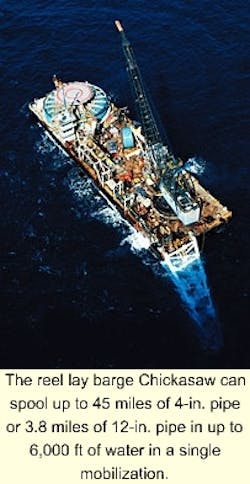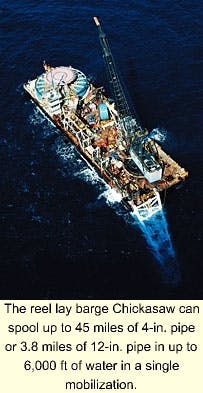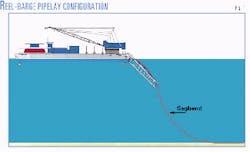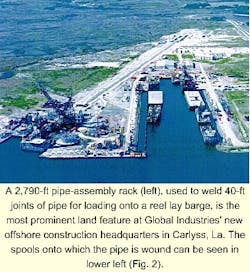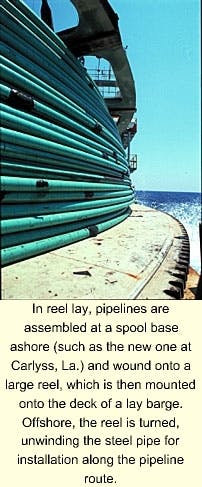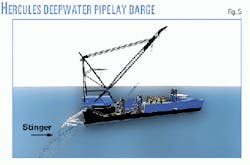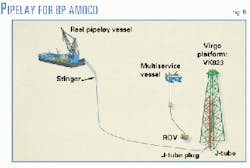Reel-barge saves time in GOM gathering-line pipelay
BP Amoco Pipeline Co., Houston, construction manager and operator of the Main Pass oil gathering system (MPOG), successfully avoided weather-related downtime in the Gulf of Mexico in September 1999 by reeling 8.5 miles of 85/8-in. OD pipe in water depths to 1,130 ft from the Chickasaw reel pipelay barge.
Global Industries, operator of the Chickasaw, achieved maximum lay rates of 2,500 fph, trimming about 5 days off a typical pipeline installation.
The project illustrates how reel pipelay is being used in the Gulf of Mexico to reduce the duration of offshore pipeline installations, minimize exposure to severe weather, and achieve higher-quality pipe welds, particularly as operators move into deepwater environments.
Shifting operations
For BP Amoco Pipeline and other operators, reel pipelay has improved project efficiency by shifting pipe welding and inspection operations from an offshore pipelay barge to an onshore spool-base facility. Stalks of steel pipe are welded together onshore and coiled around a large horizontal or vertical reel, mounted on the deck of the barge.
Offshore, the reel is turned, unwinding the steel pipe as the pipelay vessel moves forward along the pipeline route under the control of a dynamic-positioning system.
In conventional lay, pipelines are assembled offshore using an assembly line on the deck of the lay barge. Performing pipeline welding onshore allows reel installations to be performed up to 10 times faster offshore than conventional pipelay and requires fewer personnel at the job site.
This efficiency provides greater opportunities for pipeline installation during windows of favorable weather in the winter months. The reduced field time using the reel barge varies in proportion to the length of the pipeline.
The main limitation of reel pipelay is that it is usually restricted to pipelines smaller than 20 in. OD. The maximum pipe size that can be installed by the Chickasaw is 12 in.
Under current upgrades, the pipelay/derrick barge Hercules is being equipped by Global to reel horizontally up to 18-in. pipe in water depths to 10,000 ft.
For these lines, there must be a proper application of pipe tension to support the pipeline load and limit pipe stresses in the unsupported span or sagbend between the barge and the seabed (Fig. 1). Tensioning helps offset the added pressures placed on pipe particularly as it is being laid in water depths greater than 1,000 ft.
Along with sufficient tension, there must also be a correct selection of pipe and welding parameters for reel pipelay projects and the availability of an on-land spool-base facility.
Shore-based approach
A primitive form of reel pipelay was used during the World War II invasion at Normandy to supply fuel to Allied troops on the beach. Several small-diameter pipelines were laid rapidly for this purpose across the English Channel.
Modern reel technology emerged in the 1960s and progressed in two directions: coiled tubing for drilling operations and reel pipelay for subsea installations. The Chickasaw, which became available in 1970, became the first commercially successful reel barge in the world (Fig. 2). Global acquired the vessel in 1990 and upgraded it with a dynamic-positioning system in 1994.
Technological developments since the emergence of reel pipelay have focused on increasing reel "capacities." These have been greatly enhanced over the years, and larger, more-sophisticated pipe tensioners have been added to lay barges for deeper water developments and to accommodate larger pipe sizes for insulated pipe-in-pipe systems.
Pipe-straightening equipment has also been upgraded to reduce pipe deformation and prevent coating damage.
It was quickly recognized that onshore pipe assembly provided greater control over welding functions and repairs, at a lower cost. As a result, operators not only reduced crew sizes, crew rotations, and installation times in deepwater developments, but they also enjoyed better welds along the pipe string.
Project considerations
To ensure a flow rate of 30,000 b/d from the Virgo production platform, BP Amoco Pipeline specified that 85/8-in. OD, 0.500-in. WT, Grade X-42 pipe be used for installation in the Gulf of Mexico to support the Main Pass oil-gathering system. (Elf Exploration Inc. is operator of the Virgo platform.)
The oil line was designed to extend 8.5 miles from a J-tube at the Virgo platform, in 1,130 ft of water at Viosca Knoll Block 823, to Main Pass Block 281 in 300 ft of water. The diameter of pipe and project location made the line a likely candidate for reel lay from a dynamically positioned lay barge.
To ensure that pipe welds could sustain installation by the reel method given the chemical properties, manufacturing process, and welding procedure of the 85/8-in. pipe, Global conducted "spoolability" tests on sample welds taken from the project pipe.
Spoolability testing may include standard API 1104 testing as well as Charpy-V impact, cross-weld tensiles, and hardness surveys.
For BP Amoco Pipeline, Global used nondestructive testing on both strained and unstrained sample welds.
One of the two sample welds underwent a cycle-bend test, simulating about 2.5 times the strain placed on the pipe during actual reeling. It was compared with the unstrained sample to ensure the reeled pipe could maintain its integrity during and following the spooling process.
Spoolability tests on the 85/8-in. line verified its suitability for reel lay.
For reel lay, some of the typical operations performed onshore are loading, stacking, and handling of pipe joints; welding; weld inspection; coating of field joints; and, application of insulation systems.
Offshore, the barge crew remains responsible for pipeline installation activities exclusively, including:
- Unspooling and straightening of the pipe, which is regulated primarily with remotely controlled equipment.
- Application of anodes.
- Final pipe coating inspection and repair.
- Pipe tie-in welding for lines too long to fit on a single spool.
From its spool-base facility in Carlyss, La. (Fig. 3), Global assembled and loaded 8.5 miles of pipe from a 2,790-ft long pipe-assembly rack onto the Chickasaw.
Joints of pipe 40 ft long were welded into 2,790-ft pipe stalks, which were provisionally stored in pipe racks downstream of the firing (assembly) line. Pipe conveyors guided the pipe down the firing line and onto the pipe racks.
A spool building positioned between the pipe rack and barge provided a location for welding the 2,790-ft long stalks into a complete line as the pipe was reeled onto the barge.
Before the pipe was spooled onto the reel barge, each field joint underwent radiographic inspection to ensure that the line met project specifications and requirements. Then, the field joints were sandblasted and coated with fusion-bonded epoxy.
Finally, a cable, which had been threaded through the pipe straightener and tensioners on the barge and attached to the reel, pulled the first pipe stalk onto the barge, through the tensioners and pipe straightener, and then onto the horizontal reel.
Global mobilized the Chickasaw on Sept. 21, 1999, for the J-tube pull at the Virgo platform to the subsea tie-in location.
Project execution
The route of the proposed Main Pass oil-gathering pipeline required that Global cross four foreign pipelines between Viosca Knoll 823 and Main Pass 281.
Global used its multiservice vessel Pioneer to pre-install mats at designated locations on each of the pipelines to be crossed. To complete the crossing, the Chickasaw initiated pipeline installation across the mats by unwinding the pipe from the reel.
The pipe reel system aboard the Chickasaw consists of three main components: a large, horizontal pipe reel, a three-part aligner and pipe straightener, and a level wind system.
The reel system is mounted horizontally on the barge to lower the weight and center of gravity of the reel and spread the reel's weight along the plane of the barge. The horizontal design of the reel also eliminates the need for a massive center shaft and bearings, which can be subject to fatigue.
Because reel pipelay requires sufficient deck space to maintain the horizontal reel, the 275-ft Chickasaw features a working deck area of 3,000 sq ft. The reel itself has a 40-ft diameter core and 72-ft flange, allowing the Chickasaw to spool up to:
- 45 miles of 4-in. pipe.
- 19 miles of 6-in. pipe.
- 11.6 miles of 8-in. pipe.
- 5 miles of 10-in. pipe.
- 3.8 miles of 12-in. pipe.
As pipe was unspooled from the reel during installation of the MPOG line, it was passed through the pipe straightener to remove the residual curvature produced by the reeling process.
The pipe straightener incorporates a large bending shoe that pre-bends the pipe entering the straightener to a known, fixed radius in order to maintain the pipe straightener at a constant setting as the reel is emptied of the pipe.
The pre-bend shoe also aligns the pipe with the face of the reel so that the pipe can be wound levelly and smoothly on and off the reel. A movable bending shoe and fixed reaction shoe are used to reverse the bend and straighten the pipe as it comes off the reel.
To ensure the 8 5/8-in. pipe could be laid without being overstressed aft of the straightener-aligner, the height of all pipelay equipment on the barge-including the straightener-aligner, pipe tensioners, and pipe supports-varied dynamically to enable the pipe to be wound levelly onto and off the reel.
A computer-controlled hydraulic system coordinated the movement of the equipment.
Upon leaving the barge, the pipe was supported in the overbend by a 100-ft stinger that is attached to the stern of the barge (Fig. 3).
The stinger is a rigid structure that incorporates a series of rollers. These rollers are adjusted to ensure the pipe assumes a fixed radius of curvature in the overbend, and they support the pipe as it makes the transition from the horizontal barge deck to the much-steeper departure angle at the end of the stinger.
It was determined the 8 5/8-in. pipe could be installed at a departure angle of about 75
Results
The Chickasaw completed all installation work on the project on Oct. 2, 1999, with no major problems or changes in the scope of the project.
Only two welds were performed offshore-one from the Chickasaw to attach a flange to the end of the line and the other from an auxiliary vessel to attach a flange to the top of the pipeline as it exited the J-tube.
To monitor pipe touchdown, Global used a remotely operated vehicle to water depths of 1,150 ft from the Pioneer (Fig. 6). On average, pipe was installed at a rate of 1,475 fph, although the maximum rate rose to 2,500 fph during the course of the project.
The project was completed in one mobilization, ahead of schedule, and under budget. It was also completed just ahead of adverse weather conditions that could have resulted in downtime for the operator.
Utilization of horizontal or vertical reel pipelay in the Gulf of Mexico points to a number of advantages over conventional lay methods. For BP Amoco Pipeline, reel lay not only provided reduced exposure to severe weather, it also eliminated the need for weather-related pipeline abandonment and recovery operations.
Another advantage was that reel lay eliminated the need for pipe haul and material barges.
In conventional lay, auxiliary barges are used to transport stalks of pipe to the job site. By carrying its own pipe to the job site, the Chickasaw eliminated the need for pipe-haul barges, numerous supply runs, and additional personnel to transfer the pipe from the material barge to the lay barge for assembly and installation.
There is also a safety-risk reduction associated with reel projects based on the fact that reel lay directly reduces the amount of work, crew size, and time spent offshore by the lay barge.
About 47 offshore personnel worked aboard the Chickasaw for the BP Amoco project compared to a traditional per-shift crew of 25-60 on conventional lay jobs. This reduces the number of people working within the confines of the barge ramp and working close to the pipe when the barge was moving.
By definition, reel pipelay produces a greater portion of work with machinery, thereby reducing hands-on exposure to assembly and installation hazards offshore. Onshore, people have a large work area with more space for equipment, less time pressure under which to make necessary welding repairs, and easier access to auxiliary equipment.
In recent years, such advantages have led to the development of reel technology for the installation of steel catenary risers, which connect offshore pipelines to production platforms and other offshore facilities.
In deepwater, it is imperative to achieve near-perfect high-quality welds on steel catenary risers or risk the possibility of making unreliable connections in a high-pressure environment. Reel pipelay gives operators the opportunity to weld steel catenary risers onshore, under reduced time and environmental constraints, to make reliable welds.
Developments
One of the most significant developments in reel lay is the weldability of high-strength pipe up to API 5L, Grade X-65 standards and beyond. This trend supports the use of reel lay for deepwater installations, although it does not eliminate the need for high tensioning capacity on deepwater jobs.
On the Chickasaw, pipelay tension is provided by the reel drive system. At present, the Chickasaw can reel pipelines in water depths to 6,000 ft, with a total tensioning capacity of 180 kips.
It is also supported by a Nautronix ASK4002 dynamic-positioning system with dual redundant controls. This system enables the barge to maintain its position over the deepwater job site without mooring lines and anchors. Elimination of anchors, in turn, reduces the barge's exposure to sea-bottom features and anchor-handling tugboats.
Global's success with the Chickasaw in the Gulf of Mexico has led the development of a 116-ft diameter horizontal reel for the company's 445-ft barge Hercules. The high-capacity reel provides five times the load capacity and six times its tensioning capacity of the Chickasaw.
On the Hercules, reeled pipe is tensioned by two, track-type pipe tensioners. When fully upgraded, the Hercules will be able to reel up to 80 miles of 6-in. pipe or 10 miles of 18-in. pipe in a single mobilization.
Today, reel pipelay is being used also in the North Sea, West Africa, and Brazil. Its further development depends on the demand of oil and gas operators to promote reel lay as an option for efficient pipelay and the availability of onshore spool-base facilities.
Most operators utilizing reel lay today target small windows of good weather for installations in the construction off-season and desire time savings in the pipelay process for lines under 20 in. OD.
The authors
Mike Palmer is a project manager for the offshore pipelines division of BP Amoco Pipeline Co. Houston. He has participated in the DeepStar Project for the development of deepwater technology in the Gulf of Mexico. He holds a BS in civil engineering from Kansas State University, Manhattan.
Larry McClure is vice-president of engineering and ROV at Global Industries, Carlyss, La. He currently participates in the DeepStar Project and is a member of the Industrial Advisory Board at McNeese State University, Lake Charles, La. He holds a BS in civil engineering from the University of Washington, Seattle.
Byron Baker is vice-president of operations at Global Industries, Carlyss. He has 25 years' experience in marine construction, with experience in both Gulf of Mexico and international operations.
Don Eckert is manager of projects at Global Industries, Carlyss. He has 22 years' experience in marine construction, with specific experience in Gulf of Mexico shallow and deepwater pipeline installation. He holds a BS in civil engineering from Louisiana State University, Baton Rouge.
Bob Malahy is director of engineering at Global Industries, Houston. He has more than 20 years' experience in marine construction, including extensive deepwater experience. He holds a PhD in mechanical engineering from Rice University, Houston.
